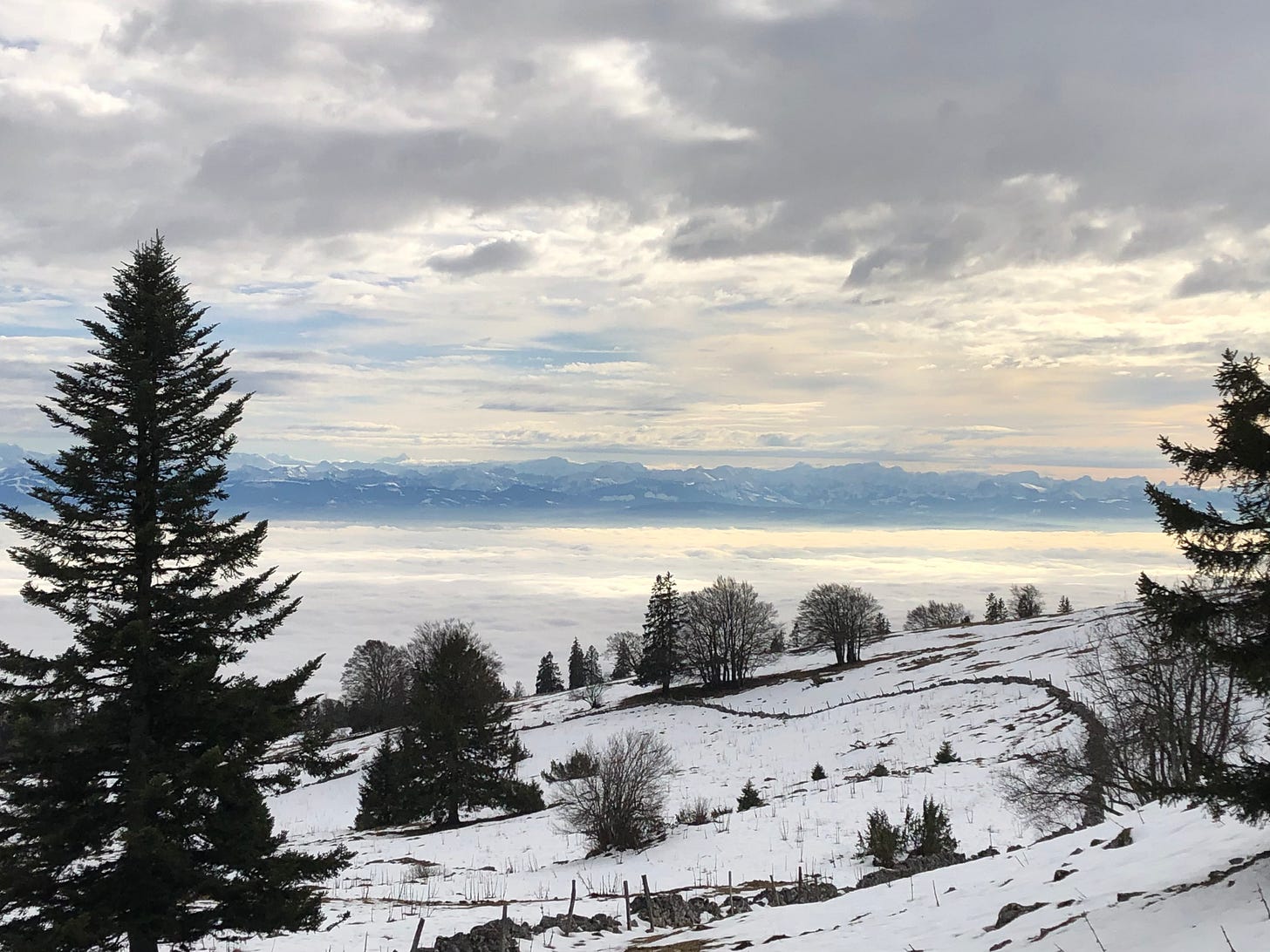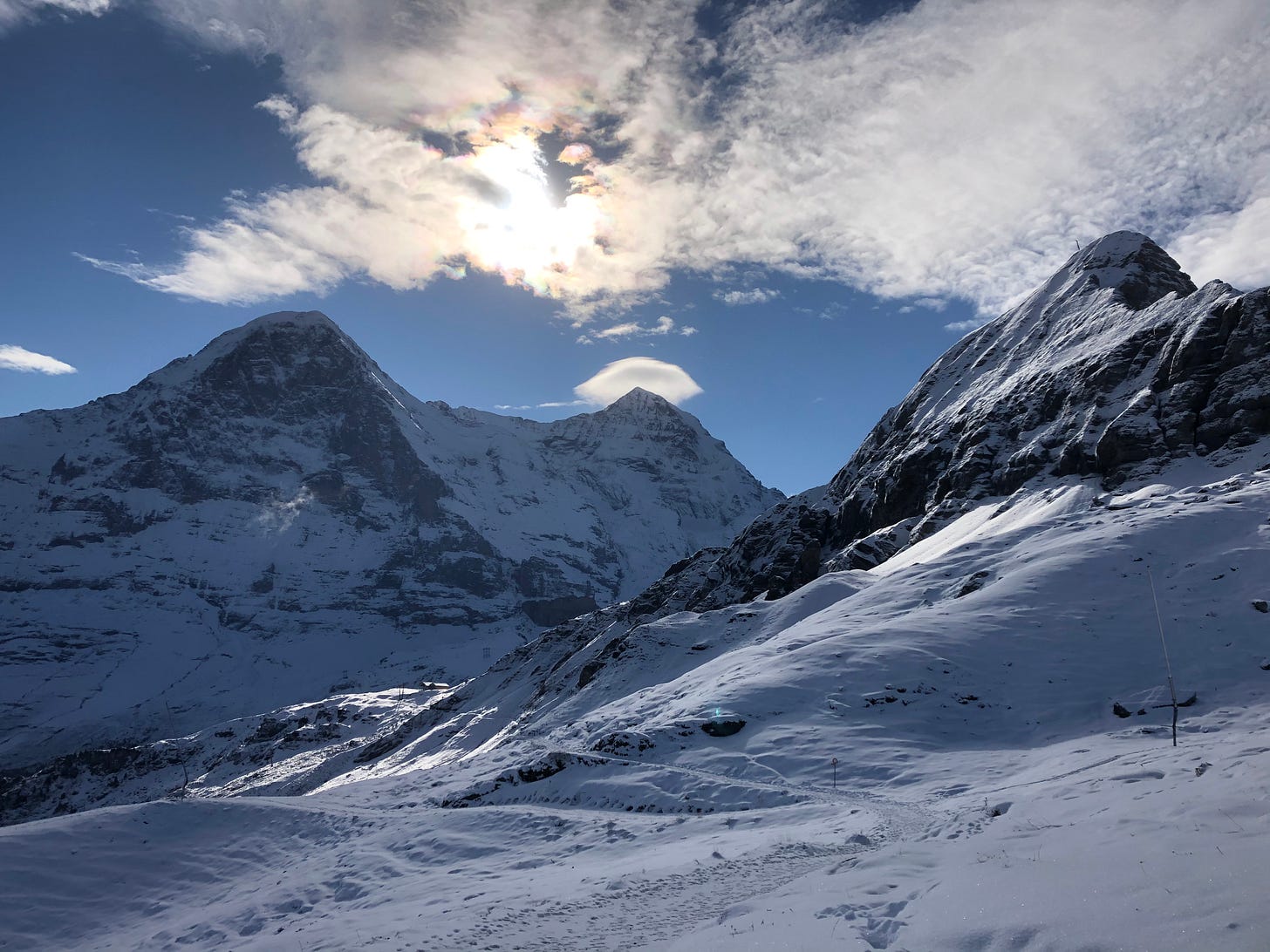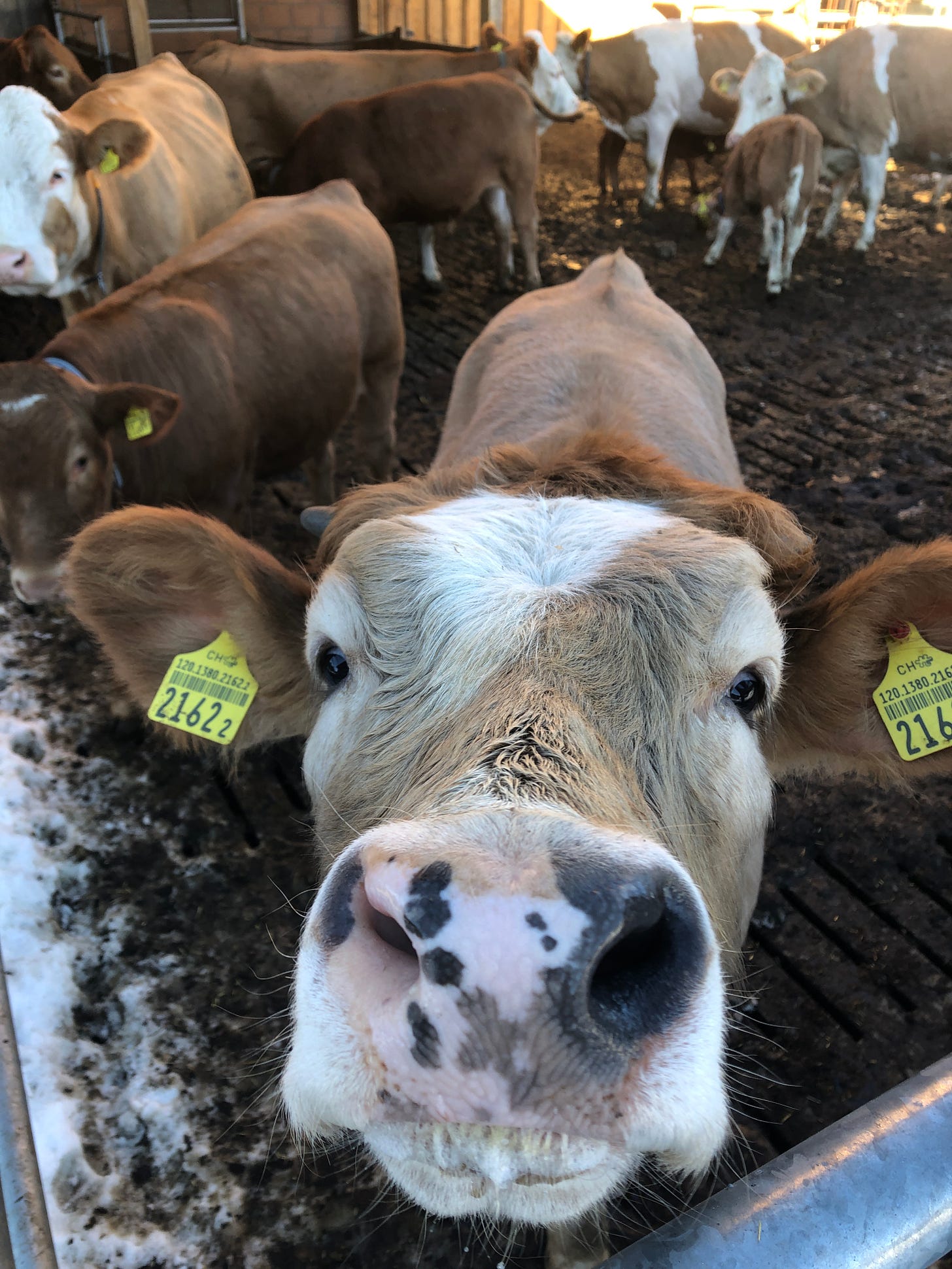Note: We’ve had a few weeks in a row of long, serious posts, and next week I will start a two-part series on Moral Foundations Theory. Plus, this week everyone in Europe is on vacation to go skiing (this is only a slight exaggeration; the Europeans really do have it all figured out, don’t they?). So I thought we all might enjoy a shorter post with lots of pictures this week. Enjoy, and get ready to think about an ethical puzzle next week!
As anyone who has hiked with me can attest, I take photos constantly. One of my great joys is to photograph the beauty I see everywhere here in Switzerland and then share my views with friends. However, I have never been much of a photographer. I’ve never taken a class or shown any ability in the visual arts whatsoever. I use an old iPhone whose camera is nothing special. Switzerland is gratifying for amateurs like me, because it’s not difficult to get beautiful results when views like this are only a short drive away:

I used to give myself quite a hard time about my ability (or lack thereof) as a photographer. Then, one day while I was looking over the hundreds of photos I’ve taken since moving here in 2018, I realized something. To quote one of my favorite gospel songs, “I’m not what I ought to be, but I’m better than I used to be. I’m getting better all the time.”
I’d like to share some lessons I’ve learned for how to take better photographs, which, not coincidentally, also serve as lessons for how to live a happier, more meaningful life.
Practice and Cull
I have never been a fan of the idea, often attributed to William Faulkner, that we should “kill our darlings.” The idea implies that we should feel contempt rather than affection for our creations and destroy what we like best, lest its preciousness irritate our audience. But why not give our audience a little credit? Maybe they will enjoy our darlings! I prefer the idea of culling—rather than eliminate our treasures, we should get rid of the errors so that our best work can prosper. I discard five to ten photos for every one I keep. After a hike, I look over the scores of photos on my phone and am ruthless in my assessment. Of course any photo that has a problem (like bad light) gets tossed, but I also trash photos that are perfectly fine but sort of boring. I will often crop the photos that remain in order to improve the framing, but otherwise I do no further editing. All this honest judgement happens in private, so I don’t feel bad about myself for my failures; I try instead to learn from them.
This lesson—that we must practice and cull—is counterintuitive and not supported by popular ideas about genius in our culture. Just think of all those montage sequences in movies where the main character writes a requiem mass or makes a discovery or learns a new skill in the time it takes to play a song on the soundtrack. Recall the epiphanies that movie mathematicians have while standing at a chalkboard, or picture the novelist heroine covered in ink as she furiously jots down her latest inspiration. I used to be a high school English teacher, and I know whereof I speak: Many of my students had already internalized the idea that we ought to be able to just pour out onto the page those perfect works that are fully formed in our heads, as though we were Mozart or Milton.1 But in fact, for us to succeed in any endeavor, no matter how talented we are (and still more so if we lack talent!) we need to practice. And I can confirm that in my case, after having taken thousands of photos, I really have gotten better.
For example, the photo below, which I took on a hike last year to the summit of Mont Racine in the Jura mountains, is one of about fifty I took that day. Most of those photos were failures that I dispatched into the ether, because the winter light was a challenge to work with that day, and the sweep of the Alps in the far distance,2 which I had wanted so badly to capture, didn’t show up distinctly in the pale light. But this photo was a keeper. I like that even though this is a color photo, it seems almost black and white. I gave up my efforts to depict the Alps clearly; here they are a wiggly bluish horizontal line that contrasts with the diagonal slope of the gentler Jura range.
Seize Opportunities
I was driving across a rural part of Switzerland on my way to a hike in Canton Fribourg when I caught a glimpse of a double rainbow out of the corner of my eye. I ignored the passive-aggressive instructions of Nigella,3 my GPS (“Make a U-turn at the first opportunity”), and turned instead down a narrow farm lane in the hopes of getting an unobstructed view of the rainbow. I parked in front of a shed next to some intimidating machinery and raced out to get this shot:
As with the photo of Oeschinnensee, the colors here are all exactly as they were that day. This is, incredibly, an unenhanced photo. The moral of the story is, when we see an opportunity, we might have had other plans. We might feel awkward about dropping everything to grab the opportunity. (I wrote about this issue in a previous post, On Offers.) We might think to ourselves, Oh, never mind. It’s not important. But most of the time, when we grab an opportunity, we will at least learn something. There might even be a pot of gold at the end of that rainbow.
Only Connect
E. M. Forster, in the epigraph to his beautiful novel Howard’s End, pleads with readers to “only connect.” The novel’s plot explores the myriad connections among people who appear to belong to different social and economic worlds, but who in fact depend upon and influence each other. I refer to that idea too, albeit metaphorically, in some of my photographs. I show that the humble details in the foreground connect with the awe-inspiring scenery in the distance. For instance, the triangular roofs over the crosses in this village cemetery are the same shape as Niesen looming over them:
The pairing of the monuments in stone with the monumental mountain links regular people to majesty and eternity.
In other cases, apparently insignificant details become the focus of the photo’s energy:
The little berries draw our eye along the diagonal and split the image. Small, apparently insignificant details, like the ordinary people we meet every day, are worth our notice; they literally affect the big picture.
Break the Rules (Sometimes)
Appropriately enough for someone who lives in Switzerland, I am a huge fan of rules. I think rules, paradoxically, make us free.4 But sometimes you need to break the rules to get the best results. For example, most of us follow the unspoken rule that winter is not a particularly good time for a hike. Why traipse around in the snow when we could hunker down with a book by a roaring fire? Or, alternately, we could go outside and try a more exciting sport like skiing or skating or snowshoeing or sledding or snowmobiling or ice fishing or cross-country skiing5 or hockey or broomball or . . . sorry. I got carried away there. What can I say? I’m from Minnesota, and we love our winter sports. But hiking? Why bother? But I’ve actually taken some of my best hikes (and some of my best hiking photos) in the winter.
In addition, one of the fundamental rules of photography is that you should never point your camera directly at the sun. The sun will be too bright and will overwhelm and blur everything else in the image. Just the other day I had to trash every photo I took on a hike near Gerzensee (famed for its creamy and mild brie-style cheese, incidentally) because the sun was too bright, and the harsh light spoiled my pictures, leaving them bleached-out and fuzzy. On the other hand, I took the photo below on a hike near Gerzensee the previous year and got a much better result because I was working with the light rather than against it. Sometimes you have to break the rules to get the best images; sometimes you need to turn your face to the sun.
Accept Our Weaknesses and Play to Our Strengths
You may have noticed that there are no people in any of my photos. This is not just because it’s unethical to publish people’s images without their consent. The truth is, as an introvert, I do much better photographing animals and scenery than I do photographing people. I have a friend who is a brilliant portrait photographer. She has photographed our family as well as most of my Prague friends and their families a number of times. She is energetic, funny, quirky, and fascinated by people—and it shows in her results. When you look at her photos, you can almost read the thoughts and feelings of her subjects, and you can tell that everyone is having a great time too. Needless to say, I’m not like this. The photos I take of people (mostly family members) reveal everyone’s impatience (“Pictures?! Not again!”) more than their personalities.
But I do have a couple of aces in the hole. Because I have the time and ability to take strenuous hikes, I can give people access to places they might not be able to see otherwise. Take, for example, this scene from the top of Faulhorn (2681m/8800ft).
The only way you can see this view is to take a twenty-five-minute cable car ride up from Grindelwald and then hike several kilometers, the last of which is straight up a steep, switchbacky path. Or you can look at my photo. As you can see, this spot is above the tree line, and the towels and tablecloths drying in the blustery wind make a bright contrast with the austere, rocky peaks. Amazingly, there is a hotel at the summit of Faulhorn—the oldest hotel in Europe, and one of the highest-elevation hotels in the world. The supplies are brought up by helicopter twice a week, and the water for washing the towels and table linens (like the ones in the photo) comes from snow the owners store in a huge tank. In spite of the spartan conditions at such a high elevation, I know from personal experience that the hotel has delicious Bailey’s coffee.
Here’s another special scene that most people will never get to see in person. I took this photo on a winter hike last year. On the left is Eiger, in the middle is Mönch, and on the right is Tschuggen. Mönch wears a special crown, a lenticular cloud. These clouds form over obstacles high in the atmosphere and tend to stay put, to the delight of photographers. It looks a bit like a flying saucer, doesn’t it?
The wonderful thing about us humans is that we all have unique talents, and it is a privilege to be able to share them with the world. I might not be the life of the party, but I can accept that about myself, especially because while everyone else is out partying, I’m up in the mountains taking my pictures, knowing that I can connect with people in my own way when I share them.
Find a Chance to Laugh
One final life lesson from photography: We should always look for opportunities for laughter, especially at life’s absurdities. A sense of humor makes everything better, even in conditions of great suffering and adversity. There is a reason that most of the best comedians in the US are Black or Jewish, and that Russians during the Soviet era created a hilarious trove of cynical jokes. I am lucky that I have never faced any real adversity, but I still love the chance to laugh, and Switzerland’s cows help me out. For example, from this angle, this calf looks like he’s wearing his own body as a little hat!
And these Highland cattle look like they’re about to drop the hottest indie album of the year. (I stole that line from this amusing page.)
How about you, readers? What life lessons have you learned from your hobbies? Please share your thoughts in the comments!
The Tidbit
There is a real Happy Wanderer!

If you drive several kilometers of tight switchbacks to 1535m/5036ft above Lake Brienz, you will find the delightful Axalp Schnitzlerweg (Woodcarving Trail). In 1999, an avalanche devastated the forest outside Axalp, leaving behind mutilated stumps. A few woodcarvers who lived in the town saw potential in the twisted stumps, so they carved whimsical figures out of them. Woodcarvers from the whole area around the avalanche showed up to create sculptures of their own and to help with the cleanup effort. (You can see more of the sculptures here.) There is now an easy, family-friendly trail looping around the sculptures so visitors can enjoy them against a backdrop of awe-inspiring mountain vistas. And this is the final lesson I’ve taken from photography, and from all of the arts. When life hands us an avalanche of destruction, we can create beauty out of the wreckage, especially if we roll up our sleeves and work together.
Or, in Milton’s case, we would conscript our daughters as amanuenses.
From our standpoint about a mile up a mountain on the French border, we could see the entire country of Switzerland at our feet.
I named her after Nigella Lawson because she has a posh accent and is a bit bossy, but she just wants to help us get the most enjoyment possible out of life.
If you are skeptical of this claim, just compare the experience of driving in Switzerland, where everyone drives at precisely the speed limit and follows all the rules and where as a consequence there are rarely traffic jams, with driving in New Jersey (which has the same number of people and similar population density), where people are constantly breaking the rules to seize a tiny advantage, clogging up intersections and causing enormous traffic jams.
Or, if you’re my dad when he was in high school, water-skiing in February down the icy Minnesota River.













Thanks for a beautiful and thoughtful piece. I agree that to get better at something we should learn to practice and cull. (Remember: How do you get to Carnegie Hall? Practice, practice, practice!) I also think that people should talk to real people more, and not watch so many movies or other fiction. Most professionals at anything know about the 10, 000 hours it takes to master a skill.
I love the rainbow picture and the red tablecloths blowing in the wind at Faulhorn. Their shadows look like a modern quilt pattern, so I’ll show that to my fabric friends’ group next week.
I’m curious as to what kind of camera you use now.
Love your pics and the idea that we get better as we work at something, not as a matter of serendipity because we have the right song playing on the soundtrack of our lives.